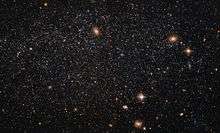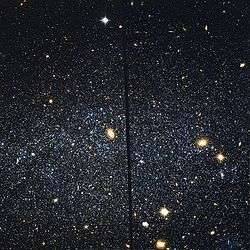Leo A
Leo A (also known as Leo III) is an irregular galaxy that is part of the Local Group. It lies 2.6 million light-years from Earth, and was discovered by Fritz Zwicky in 1942.[4] The estimated mass of this galaxy is (8.0 ± 2.7) × 107 solar masses, with at least 80% consisting of an unknown dark matter.[5] It is one of the most isolated galaxies in the Local Group and shows no indications of an interaction or merger for several billion years. However, Leo A is nearly unique among irregular galaxies in that more than 90% of its stars formed more recently than 8 billion years ago, suggesting a rather unusual evolutionary history.[6] The presence of RR Lyrae variables shows that the galaxy has an old stellar population that is up to 10 billion years in age.[7]

| Leo A | |
|---|---|
 Leo A by Hubble Space Telescope | |
| Observation data (J2000 epoch) | |
| Constellation | Leo |
| Right ascension | 09h 59m 26.4s[1] |
| Declination | +30° 44′ 47″[1] |
| Redshift | 0.000067[1] |
| Distance | 2.6 ± 0.1 Mly (790 ± 40 kpc)[2][3] |
| Apparent magnitude (V) | 12.9[1] |
| Characteristics | |
| Type | IBm[1] |
| Apparent size (V) | 5′.1 × 3′.1[1] |
| Other designations | |
| Leo III, UGC 5364, DDO 69, PGC 28868[1] | |
The neutral hydrogen in this galaxy occupies in a volume similar to its optical extent, and is distributed in a squashed, uneven ring. The galaxy is not rotating and the hydrogen is moving about in random clumps. The proportion of elements with higher atomic numbers than helium is only about 1-2% of the ratio in the Sun. This indicates a much less complete conversion of gas into stars than in the Milky Way galaxy. The Leo A galaxy shows sign of increased star formation some time within the last 1-4 billion years, although the current level is low. There are four H II regions powered by short-lived, O-class stars.[9]
References
- "NASA/IPAC Extragalactic Database". Results for Leo A. Retrieved 2006-11-19.
- I. D. Karachentsev; V. E. Karachentseva; W. K. Hutchmeier; D. I. Makarov (2004). "A Catalog of Neighboring Galaxies". Astronomical Journal. 12745345 (4): 2031–2068. Bibcode:2004AJ....127.2031K. doi:10.1086/382905.
- Karachentsev, I. D.; Kashibadze, O. G. (2006). "Masses of the local group and of the M81 group estimated from distortions in the local velocity field". Astrophysics. 49 (1): 3–18. Bibcode:2006Ap.....49....3K. doi:10.1007/s10511-006-0002-6.
- Zwicky, F (April 1942). "On the Large Scale Distribution of Matter in the Universe" (PDF). Physical Review. 61 (7–8): 489–503. Bibcode:1942PhRv...61..489Z. doi:10.1103/PhysRev.61.489.
- Brown, Warren R.; et al. (September 2007). "Stellar Velocity Dispersion of the Leo A Dwarf Galaxy". The Astrophysical Journal. 666 (1): 231–235. arXiv:0705.1093. Bibcode:2007ApJ...666..231B. doi:10.1086/519547.
- Cole, Andrew; et al. (March 2007). "Leo A: A Late-blooming Survivor of the Epoch of Reionization in the Local Group". The Astrophysical Journal Letters. 659 (1): L17-20. arXiv:astro-ph/0702646. Bibcode:2007ApJ...659L..17C. doi:10.1086/516711.
- Vansevičius, Vladas; et al. (August 2008). "The Full-fledged Dwarf Irregular Galaxy Leo A". The Astrophysical Journal. 611 (2): L93–L96. arXiv:astro-ph/0405313. Bibcode:2004ApJ...611L..93V. doi:10.1086/423802.
- "A case of suspended animation?". Retrieved 11 April 2016.
- Young, L. M.; Lo, K. Y. (1996). "The Neutral Interstellar Medium in Nearby Dwarf Galaxies. I. Leo A". Astrophysical Journal. 462: 203–214. Bibcode:1996ApJ...462..203Y. doi:10.1086/177141.
External links

- Leo A on WikiSky: DSS2, SDSS, GALEX, IRAS, Hydrogen α, X-Ray, Astrophoto, Sky Map, Articles and images